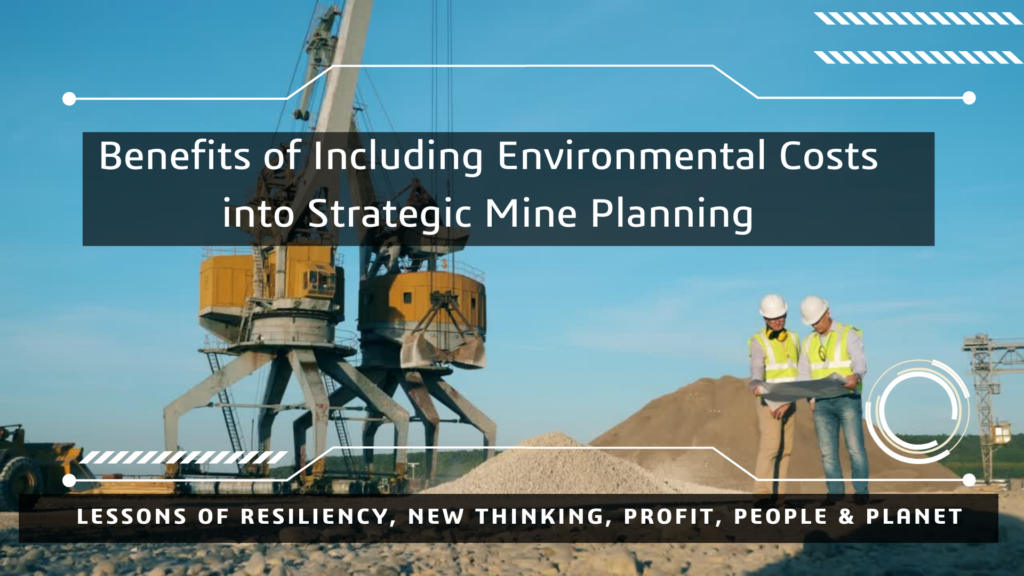
Countless reports chronicle mining’s lackluster pace of innovation, and the industry offers plenty of explanations, but the truth is that poor planning and inefficient operations pummel bottom lines as much as rising costs, volatile markets, diminishing resources, and tightening regulations.
Lessons of Resiliency
It’s remarkable that ecological costs typically are not included in conventional Strategic Mine Planning (SMP), especially since growth in the industry depends increasingly on institutional investors who demand sustainability metrics for investment analyses. Conventional SMP focuses on productivity and optimized production scale that maximizes value, factoring price uncertainties, assessing different investment levels and defining strategic features of a project to help create confidence in key decisions.
Ecological factors, however, don’t usually get added to models that produce optimized Net Present Value (NPV). Some ecological assessments might be included as qualitative notes but do not provide economic parameters for comprehensive planning.
Which is astounding because, if the industry learned anything since 2020 when COVID-19 swept the world, it is that uncertainty demands better planning. Price shocks, demand disruption, destabilized supply-demand balance, and a “new normal” of macroeconomics forced companies to plan with an eye on de-risking against uncertainty.
Planners learned to simulate complex geometries of NPV reflecting thousands of possible scenarios that gave decision-makers improved confidence in their choices. With so many scenarios on the table, some planners were surprised to learn that some optimized outcomes seemed counter-intuitive, such as achieving higher NPV with reduced production.
New Thinking
We’re not talking about investments in large-scale sustainable technologies such as automation and renewable energy electrification, admittedly hard to implement in a business where cycles swing, markets roil, prices fluctuate, community relations fall apart, regulations mount, and ore reserves dwindle.
Including ecological costs in Net Present Value calculations isn’t new technology. It’s new thinking. That thinking challenges a prevailing assumption that ecological costs hurt the overall business valuation of a project. That’s simply not necessarily true. It is true that ecological costs will rise. Perhaps planners don’t know how to include ecological costs, or which cost, or what categories of costs to focus on. How are “ecological services” defined?
Planners already accomplish herculean feats with conventional mine planning that produces wide-ranging mine and plant scenarios to optimize a project’s economic value, robustness and reliability. A conventional Strategic Mine Plan is versatile over a mixture of mining methods, including surface, underground, and caving mines. It visualizes all possible options of investment scenarios and optimizes mine capacity and cut-off grade. By incorporating price uncertainty, an optimized SMP can minimize risk, making production more robust in the face of changing market cycles.
But it can’t reflect true operating costs and profitability without ecological variables factored into the equation. Water, energy, public health, goodwill, government relations, taxes and fines, nearly all sectors of business and social activity feel the ripples of climate change and environmental quality. And since the mining industry contributes significantly to the acceleration of global warming and ecological degradation, it seems a bit indefensible to ignore mine planning solutions that quantify and calculate ecological costs into a new “Green NPV.”
Profit, People, Planet
It’s not that the industry hasn’t known for years that climate change and environmental degradation pose serious constraints on mining’s future. The industry has taken steps and gotten support. The Kellogg Innovation Network at Northwestern University set out a framework in 2015 to help mining companies develop sustainable projects and still boost profits. The Initiative for Responsible Mining Assurance (IRMA) supports sustainable mining with independent third-party verification and certification of sound environmental mining practices.
Green NPV represents a relatively simple step companies can take to refine NPV with ecological costs while limiting risks of incurring future environmental costs. And it does something more. Green NPV advances the “triple-bottom line” business concept of measuring social and environmental impact along with financial performance: profit, people, and planet. The standard “bottom line” is profit only. That’s simply insufficient.
In the next and final instalment of this series, we explain how mining companies can engage with Strategic Mine Planning solutions that include ecological costs as well as the risks of failing to do so.
You can also download the eBook from the GEOVIA User Community
Community is a place for GEOVIA users – from beginners to experts and everyone in between – to get answers to your questions, learn from each other, and network. Join our community to know more:
GEOVIA User Community – Read about industry topics from GEOVIA experts, be the first to know about new product releases and product tips and tricks, and share information and questions with your peers. All industry professionals are welcome to learn, engage, discover and share knowledge to shape a sustainable future of mining.
New member? Create an account, it’s free! Learn more about this community HERE.
